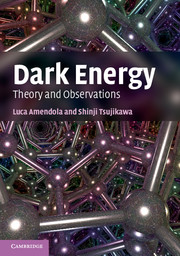Book contents
- Frontmatter
- Contents
- Preface
- List of Frequently used symbols
- 1 Overview
- 2 Expansion history of the Universe
- 3 Correlation function and power spectrum
- 4 Basics of cosmological perturbation theory
- 5 Observational evidence of dark energy
- 6 Cosmological constant
- 7 Dark energy as a modified form of matter I: Quintessence
- 8 Dark energy as a modified form of matter II
- 9 Dark energy as a modification of gravity
- 10 Cosmic acceleration without dark energy
- 11 Dark energy and linear cosmological perturbations
- 12 Non-linear cosmological perturbations
- 13 Statistical methods in cosmology
- 14 Future observational constraints on the nature of dark energy
- 15 Conclusion and outlook
- 16 Answers to the problems
- 17 Mathematical Appendix
- References
- Index
14 - Future observational constraints on the nature of dark energy
Published online by Cambridge University Press: 05 March 2013
- Frontmatter
- Contents
- Preface
- List of Frequently used symbols
- 1 Overview
- 2 Expansion history of the Universe
- 3 Correlation function and power spectrum
- 4 Basics of cosmological perturbation theory
- 5 Observational evidence of dark energy
- 6 Cosmological constant
- 7 Dark energy as a modified form of matter I: Quintessence
- 8 Dark energy as a modified form of matter II
- 9 Dark energy as a modification of gravity
- 10 Cosmic acceleration without dark energy
- 11 Dark energy and linear cosmological perturbations
- 12 Non-linear cosmological perturbations
- 13 Statistical methods in cosmology
- 14 Future observational constraints on the nature of dark energy
- 15 Conclusion and outlook
- 16 Answers to the problems
- 17 Mathematical Appendix
- References
- Index
Summary
The observables used to obtain information about the global properties of the Universe are not many: distances, background radiation, source positions and velocities, galaxy shapes as an indicator of lensing shear, galaxy or cluster densities, all of them as functions of redshift. All these observables can in principle be employed to constrain the properties of dark energy. Five methods emerged so far as possibly the best tools for exploring the property of dark energy: SN Ia, CMB, LSS (including BAO), weak lensing and galaxy clusters. In some cases this selection was based on the actual current performance (e.g., the SN Ia method that gave birth to the whole dark energy concept); in others, on good promises for the next decade (e.g., weak lensing).
In Section 5.2 we already addressed the SN Ia method in some detail. In this chapter we discuss the other techniques and their prospects. We also explain the potential of alternativemethods such as age tests, gamma ray bursts, strong lensing, and redshift drift.
Dark energy and the CMB
The physics of CMB is a wonderful playground for cosmologists. The initial conditions are set by inflation; the evolution of perturbations involves the delicate interplay of photons, baryons, neutrinos, dark matter, and dark energy, all coupled either directly or via the gravitational field. Finally, the observation and the analysis of the anisotropies themselves also involve very interesting physics, mathematics, and statistics.
- Type
- Chapter
- Information
- Dark EnergyTheory and Observations, pp. 383 - 426Publisher: Cambridge University PressPrint publication year: 2010



